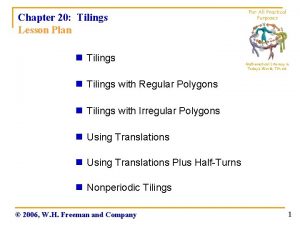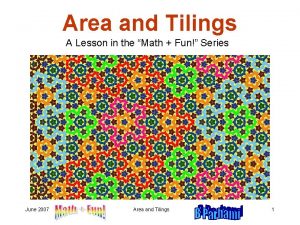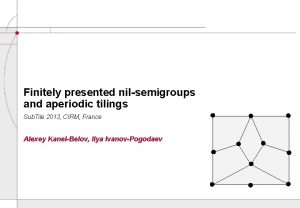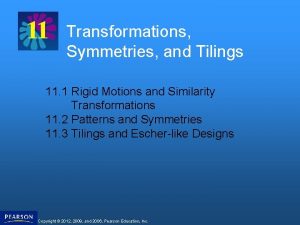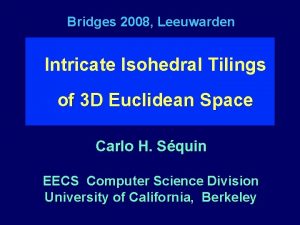Area and Tilings A Lesson in the Math
















- Slides: 16

Area and Tilings A Lesson in the “Math + Fun!” Series June 2007 Area and Tilings 1

About This Presentation This presentation is part of the “Math + Fun!” series devised by Behrooz Parhami, Professor of Computer Engineering at University of California, Santa Barbara. It was first prepared for special lessons in mathematics at Goleta Family School during four school years (2003 -07). “Math + Fun!” material can be used freely in teaching and other educational settings. Unauthorized uses are strictly prohibited. © Behrooz Parhami June 2007 Edition Released First June 2007 Revised Area and Tilings Revised 2

Finding the Area of a Geometric Shape Circle Square Rectangle Area = Side 2 Area = Width Height Triangle Area = Base Height / 2 Area = (p/4) Diameter 2 = p Radius 2 Triangle Area = Base Height / 2 The area of a circle is about 80% of the square that encloses it The area of a triangle is half that of a rectangle that encloses it June 2007 Area and Tilings 3

Activity 1: The Area of a Triangle On a sturdy piece of cardboard, draw a 4” 6” rectangle Place thumbtacks or pushpins into the two lower corners Put a rubber band around the two thumbtacks or pushpins and stretch it so that it forms a triangle, with the top vertex at the upper left corner of the rectangle. Is it obvious that the area of the triangle is half the area of the rectangle? Now, slowly move the rubber band so that the top vertex shifts to the right along the rectangle’s top edge. What happens to the area of the triangle as you move the top vertex? Area and Tilings June 2007 4

Measuring the Area of an Irregular Shape Method 1: Approximate the irregular shape by a regular one Method 2: Cover with 1 1 tiles; count whole tiles and half of broken ones June 2007 Area and Tilings 5

Activity 2: Tiling an Area with Square Tiles Draw a large irregular area on a piece of cardboard or construction paper Draw a straight line through the middle of the area in any direction Use square post-it notes as your tiles 15” or more Place tiles, one by one, on one side of the straight line that you have drawn, taking care that the tiles are aligned and there is no gap between them (real tilers actually leave a gap between tiles where they will pour the grout) Now, moving up and down from the row of tiles placed next to the line, finish tiling of the area, leaving spaces only where whole tiles would not fit; make sure the tile sides are perfectly aligned, with no gap between them Cut tiles to appropriate shapes to fill the irregular areas at the edges Taking your tiles to be 1’ 1’, estimate the area of the irregular shape in ft 2 June 2007 Area and Tilings 6

Simple Tilings with Nonsquare Tiles Any shape with right angles and side lengths that are integers can be tiled using 1 1 tiles. Some, but not all, shapes can be tiled using 1 2 tiles To be completely covered with 1 2 tiles, a shape’s area must be even, but this is not enough June 2007 Area and Tilings 7

Covering a Chess Board with 1 2 Tiles A chess board, or any rectangle with at least one even side, can be completely covered with 1 2 tiles What if we remove two squares at opposite corners? June 2007 Area and Tilings 8

Activity 3: Tiling with 1 2 Tiles Tile a 4 6 rectangle using 1 2 tiles of two different colors. Try to find at least two tilings that look nice (have interesting color patterns) June 2007 Area and Tilings 9

Activity 4: Tiling with L-Shaped Tiles Tile a 4 6 rectangle using L-shaped tiles that cover three squares. Is there more than one way to do this? June 2007 Area and Tilings 10

Some Possible 1 2 Tiling Patterns Mixed with 1 x 1 Challenge: Try to come up with other ways of mixing 1 2 and 1 1 tiles June 2007 Area and Tilings 11

Some Irregular Tiling Patterns Challenge: Try to come up with other interesting irregular tiling patterns June 2007 Area and Tilings 12

Triangular, Hexagonal, and Other Patterns These mixed hexagonal and pentagonal tiles don’t quite cover a flat surface area but. . . June 2007 Area and Tilings 13

Activity 5: Mixed Triangular and Hexagonal Tiles Cut out a number of hexagonal and triangular tiles with sides of equal length (use paper of different colors) and use them to tile a square area June 2007 Area and Tilings 14

Two-Color Tiles June 2007 Area and Tilings 15

Multicolor and Patterned Tiles June 2007 Area and Tilings 16
 Math game math hit the button
Math game math hit the button Hát kết hợp bộ gõ cơ thể
Hát kết hợp bộ gõ cơ thể Frameset trong html5
Frameset trong html5 Bổ thể
Bổ thể Tỉ lệ cơ thể trẻ em
Tỉ lệ cơ thể trẻ em Chó sói
Chó sói Tư thế worm breton là gì
Tư thế worm breton là gì Chúa yêu trần thế
Chúa yêu trần thế Môn thể thao bắt đầu bằng chữ f
Môn thể thao bắt đầu bằng chữ f Thế nào là hệ số cao nhất
Thế nào là hệ số cao nhất Các châu lục và đại dương trên thế giới
Các châu lục và đại dương trên thế giới Công thức tính độ biến thiên đông lượng
Công thức tính độ biến thiên đông lượng Trời xanh đây là của chúng ta thể thơ
Trời xanh đây là của chúng ta thể thơ Cách giải mật thư tọa độ
Cách giải mật thư tọa độ 101012 bằng
101012 bằng Phản ứng thế ankan
Phản ứng thế ankan Các châu lục và đại dương trên thế giới
Các châu lục và đại dương trên thế giới

















